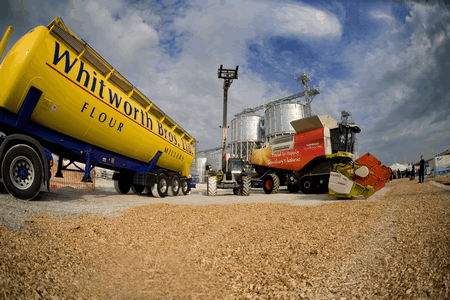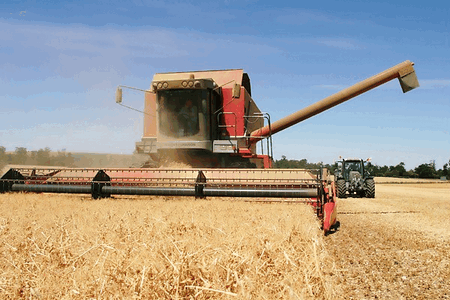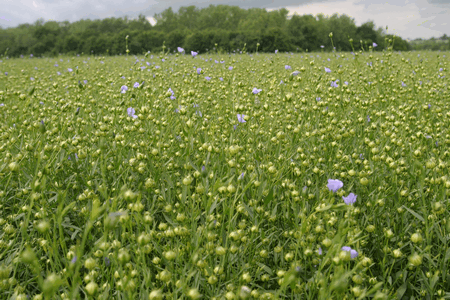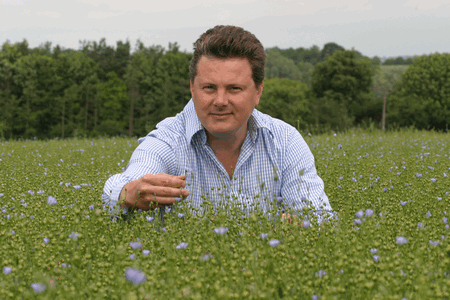Can winter linseed become a useful alternative to osr and beans?

Many growers who tried winter linseed a decade ago might be tempted to run for the hills at its very mention.
Such is the legacy of a crop that eventually proved anything but suitable for the UK climate. High seed rates were recommended to try to safeguard against winter losses, with the inevitable consequences. In severe weather the crop still failed completely, while in milder conditions every plant survived and the over-thick stand eventually collapsed into a tangled mess.
But things have come a long way in the past decade, Nigel Bazeley of Premium Crops, Hampshire, insists. Agronomically, the three autumn-sown varieties marketed under the WintaLin brand stack up, he says, and there is a strong market for the produce, too.
“Winter linseed suffered from something of a false dawn,” he notes. “But this is a totally different crop. Excellent winter hardiness and lodging resistance make WintaLin a consistent and reliable performer.”

About 1000ha (2471 acres) of the crop is being grown in the UK this season, and it has been trialled and grown commercially on a small scale for at least four years. Mr Bazeley has enough seed for up to 6000ha (14,826 acres) next season and believes 20,000-50,000ha (49,420-123,550 acres) could eventually be grown here.
He says the crop deserves to be considered as a serious third break choice for this autumn. “I am not saying it is an oilseed rape replacer – far from it, as that crop has a bright future.
“But some growers who have grown rape in a tight rotation are running into problems and experiencing lower yields, perhaps from club root or sclerotinia,” he says.
“Others are worried about building up such problems, and some growers also experienced horrendous slug damage last autumn in following wheat crops. Wintalin offers an alternative, has a much better margin than beans, and can still be grown in the same rotation as rape.”

Although there are three varieties marketed as WintaLin, there is very little to choose between them, says Mr Bazeley. “Rather than confuse with varieties we’ve gone for a brand.”
The crop is best sown from mid-September to mid-October, says Mr Bazeley, at 550 seeds/sq m. That should produce about 400 plants/sq m coming into the spring, but with the advent of Caramba and Folicur as growth regulators there is some leeway, he notes.
“We have a vastly improved agronomy package compared with a decade ago, and we can really manage crop growth. And a new recommendation means Crawler can now be applied to the crop to tackle resistant blackgrass. Agronomists also know how to clean up weeds in the spring.”
The crop is ready to harvest in late July, much earlier than the spring crop, and is likely to need less drying, he adds.
A key advantage is that WintaLin only needs on average about 120kg/ha of nitrogen, just over half of what might typically be applied to a rape crop, say Mr Bazeley. That saves about £100/ha.
The crop also attracts a typical premium of £50/t – the actual figure varies from £45 when rape is worth £300/t to £56 at £375/t.
The nitrogen saving combined with the premium means WintaLin margins outstrip beans (see table). The figures, which Mr Bazeley says come from a range of commercial growers, also show the crop starting to give oilseed rape a run for its money, he adds.
Linseed in demand
Farmers wishing to grow WintaLin can choose between seed-only deals or buy-back contracts, available from Premium Crops, Masstock and Grainfarmers.
Farms from the south coast to Yorkshire are being sought, not because of agronomic limitations, but because of market logistics, says Mr Bazeley.

Unusually, the contracts are area- rather than tonnage-based. “There is a huge amount of trust involved, but now that the subsidy system has changed growers know they have to maximise yields, and treat the crop accordingly,” says Mr Bazeley.
“If you are contracted to fixed tonnage and undershoot, you don’t get the best price for all your produce. And if you undershoot, you can be held in default. This area contract avoids those problems.”
Premium Crops supplies about a third of the 50,000t a year of linseed that French company Valorex heats and extrudes before selling on to animal feed firms.
The ingredient is rich in omega 3 fatty acids, and typically makes up 5% of a feed ration. Animals fed on this produce milk, meat and eggs rich in the fatty acid that the human diet lacks, says Mr Bazeley.
“Valorex has developed a fully traceable supply chain, and over 200 products are now labelled in French supermarkets. The market is taking off on the Continent, and we’re starting to get going here. It’s a very exciting market, and that’s why I’m confident about the future.”
Gross margins £/ha Winter rape Winter beans WintaLin Yield (t/ha) 3.4 4.2 2.6 Value 350 160 400 Output 1,190 672 1,040 Variable costs 493 267 412 Gross margin 697 405 628 Source: Premium Crops
Faring well in the east
James Nott is happy with WintaLin’s performance so far.
James Nott, near Halstead, Essex, has never grown linseed before but says his 16ha (39.5-acre) crop of WintaLin looks promising. The variety, Oleane, is being grown for seed.
“The land was sick of oilseed rape, and this looked a better alternative to beans,” says Mr Nott. “My agronomist tells me it looks completely different to Oliver.”

Better standing power and a much- improved chemical armoury have helped keep the crop looking well. “We can use products like Crawler, Lexus and Eagle which offer a fair spectrum of weed control.
“And fungicides like Caramba and Folicur are available for disease control and their growth regulatory effects.”
While the combine will reveal how the crop has really fared, Mr Nott has signed up to grow more next season. “I’m giving it two years to see what it can do.”
